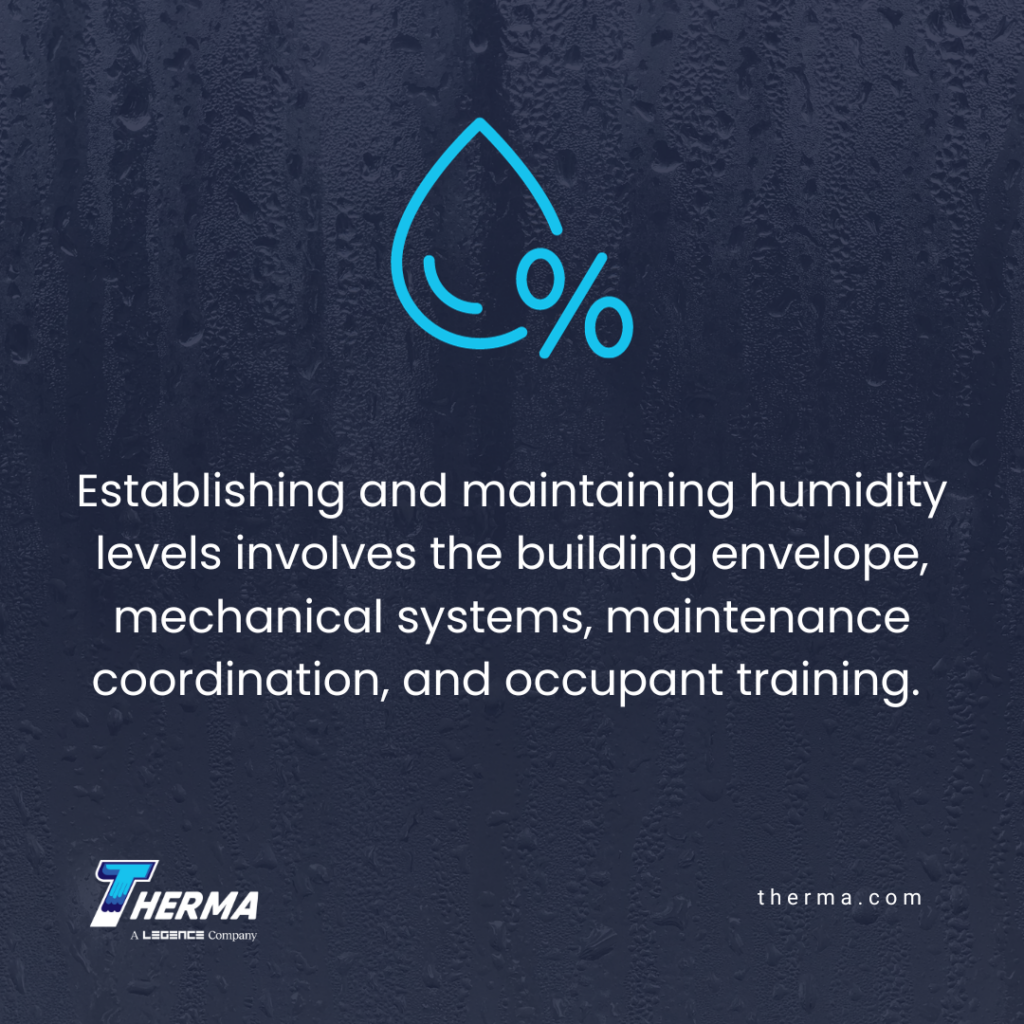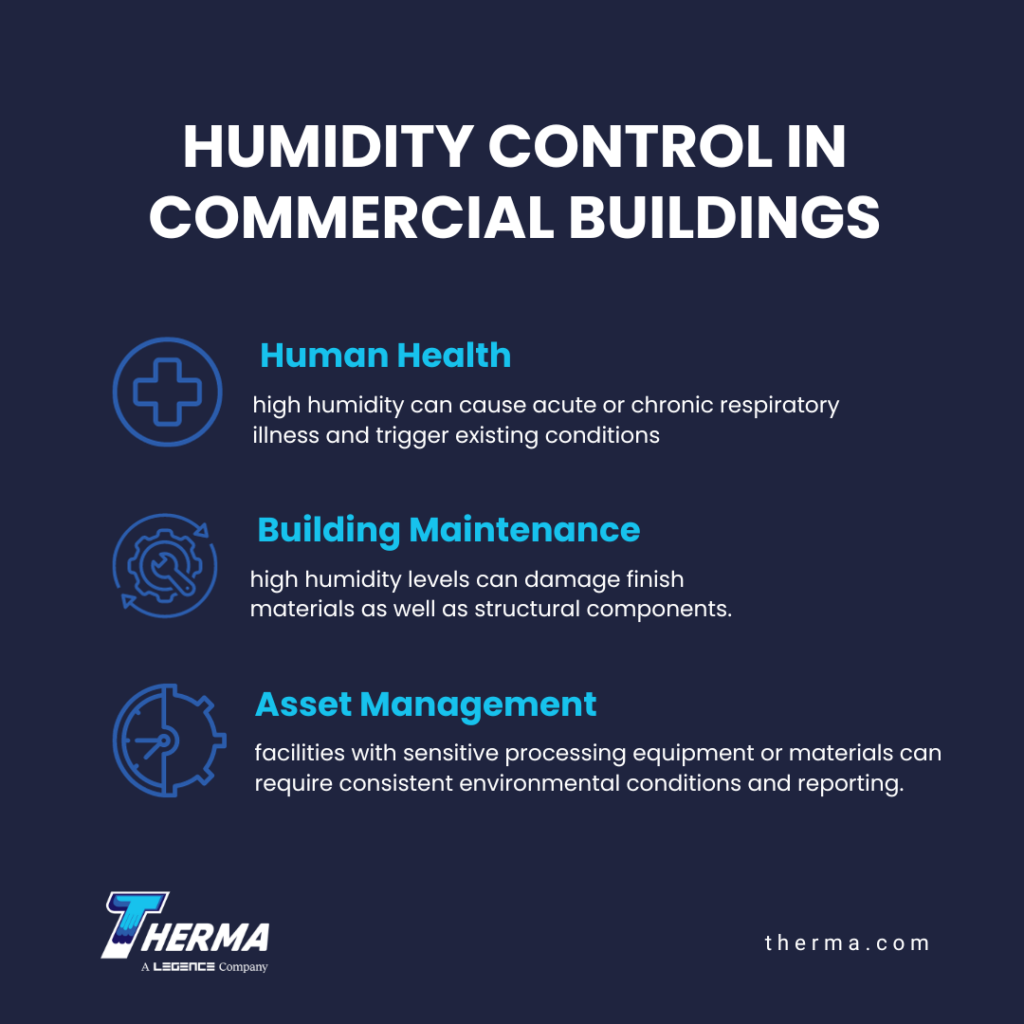by Ali Kriscenski
Environmental conditions in buildings and facilities impact occupant health, structure integrity, regulatory compliance, and building performance. Humidity control is a significant component of creating optimal indoor climates that support productivity, wellness, and operational efficiency. This article gives an overview of key elements that affect humidity and how you can take control.
Humidity Control Challenges
In recent years, building productivity and occupancy have experienced erratic patterns. In many instances, programs and processes that were left vacant for long periods created building maintenance issues, including mold and mildew from increased humidity.
These issues have always been a challenge for facility managers, but have gained more attention during the pandemic. On the upside, the recent experiences created focused solutions that can be applied in any circumstance.
Humidity control is important to human health, building materials, and valuable equipment or inventory. As part of overall environmental conditions, proper humidity levels can alleviate operational expenses due to employee absenteeism, equipment failure, building repairs, inventory damage, and even fines.
Humidity and Human Health
Buildings and facilities where people work or live have an impact on human health. High humidity can cause acute or chronic respiratory illness and trigger existing conditions, such as asthma. High humidity can exacerbate a number of health issues including lethargy, dermatitis, eczema, dehydration, and hyperthermia.
Humidity and Building Maintenance
Building materials can be adversely affected by moisture and humidity. Conditions with high humidity levels can damage finish materials as well as structural components. When building materials are compromised through warping or buckling, buildings can become exposed to the weather creating additional damage from rain, ice, and unconditioned air.
Humidity and Asset Management
For facilities with sensitive processing equipment or materials, humidity levels can become part of regulatory compliance. For example, pharmaceutical manufacturing and storage require consistent environmental conditions and reporting.
How to Manage Humidity
Establishing and maintaining humidity levels involves the building envelope, mechanical systems, maintenance coordination, and occupant training.
When compromised, building envelopes can allow moisture and unconditioned air into controlled climate spaces and upset ideal environmental conditions. As part of regular building maintenance, a survey of roofing, siding, windows, and doors can help identify where repairs or replacements are needed.
Regular maintenance can also help keep mechanical systems running at optimal performance. The test and balance process can reveal any system variances, damaged components, or calibration needed. This process helps improve indoor air quality by improving temperature, airflow, and humidity settings.
Educating employees and occupants on IAQ can create a sense of ownership that empowers them to contribute to building maintenance. Simple systems like signage with facility manager contacts can help occupants raise issues before larger problems occur. Broken windows, thermal comfort variances, leaks, or other issues can easily be conveyed to the maintenance team with established communication channels.

Benefits of Automated Monitoring
The benefits of automated environmental conditions monitoring and reporting can outweigh the costs. Many devices provide data on temperature, humidity, and access or entry events. This type of consistent observation can help find early signs of system default, identify authorized personnel access, and provide reporting for regulatory compliance.
Automated monitoring can be especially useful in healthcare settings to ensure healthy IAQ, designated isolation areas, and maintain medical assets such as vaccines and calibrated equipment. These same benefits can be utilized in manufacturing facilities, bio-pharmaceutical plants, and other facilities that depend on controlled environmental conditions.
Whether you are building a new facility or looking to improve existing systems, attention to humidity control will have a positive return. Therma’s team of experts can help you navigate building performance and work with you to create effective long-term strategies. Contact Therma today to learn more.
AUTHOR BIO
Ali Kriscenski was trained in high-performance building design at Boston Architectural College. She has worked with leading architecture and construction firms in NYC and New England and served on the executive team at the Forest Stewardship Council International. She was the managing editor at Inhabitat and has worked pro bono for the Green Building Institute, ISEAL Alliance, and Habitat for Humanity.
Sources
EPA – Indoor Air Quality
IAQ Works – Humidity and Indoor Air Quality
Pharma Processing World – The Significance of Humidity Control in GMP Compliance








